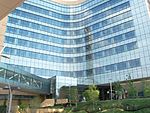Baujan Field
1925 establishments in OhioCollege soccer venues in the United StatesDayton Flyers soccerDefunct college football venuesSoccer venues in Ohio ... and 2 more
Sports venues completed in 1925Sports venues in Dayton, Ohio

Baujan Field is a soccer-specific stadium located in Dayton, Ohio on the University of Dayton campus. Its main tenants are the Dayton Flyers men's and women's soccer teams. It was originally built in 1925 as UD's main athletic field, and was named in honor of longtime head football coach Harry Baujan in 1961. After the football team moved to Welcome Stadium in 1974, the concrete grandstand was torn down, and it was retrofitted for soccer. Bleachers were the only seats available from then until 2000, when a terraced seating section was carved into the hillside.
Excerpt from the Wikipedia article Baujan Field (License: CC BY-SA 3.0, Authors, Images).Baujan Field
Stonemill Road, Dayton
Geographical coordinates (GPS) Address Nearby Places Show on map
Geographical coordinates (GPS)
| Latitude | Longitude |
|---|---|
| N 39.738058 ° | E -84.177848 ° |
Address
Baujan Field
Stonemill Road
45409 Dayton
Ohio, United States
Open on Google Maps





